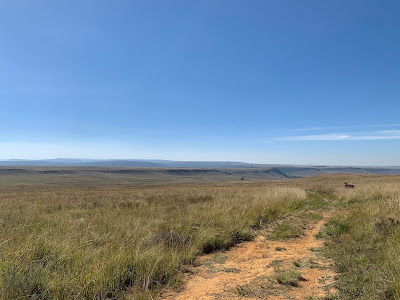As I had most of Sunday in Jo'burg, I managed to find a local bird guide called Wian van Zyl to take me out for the day. I handed over a list of birds which were new to me (only five or six species) and I let Wian sort the rest.
Wian picked me up at the airport hotel at 5.30am (breakfast helpfully served from 4am) and off we went heading west to the Guateng region. Wian was excellent company throughout and we had a superb day, this despite the majority of my target species not appearing.
A Black/Great Sparrowhawk flew over us at some traffic lights and close to the entrance of Ezemvelo, we found a Black-shouldered Kite, Southern Fiscal, Cape Grassbird, Levaillant's Cisticola and Ostrich. We entered the reserve and a start/stop drive in this predator-free reserve was mostly quiet, but I was more than happy observing some excellent antelopes. Most interesting to me were Black Wildebeest, Blesbok, Plains Zebra and a Common Duiker, plus a Black-backed Jackal was also seen.
Noteworthy birds were some stunning Red-throated Wryneck; Buffy Pipit was new, plus Greater Double-collared Sunbird, Spotted Thick-knee, Brubru, Black-chested Prinia and Cape Longclaw as we progressed the dusty track. At the accommodation block, things spiced up a bit with one of my targets coming into some playback, this being a Striped Pipit. The pipit showed brilliantly for 10-minutes. A Mocking Cliff Chat, Chinspot Batis, Violet-backed Starling, Banded Martin, Bar-throated Apalis and Southern Black Flycatcher were also here, adding to the joys of encountering these excellent species after such a long gap. A drive further out into the reserve added some larks and pipits to the day, with Eastern Clapper (new) and Spike-heeled Larks, and, Nicholson's Pipit, plus Cloud Cisticola and a Pearl-breasted Swallow flew through.
One species that has eluded me during my trips to Africa is African Cuckoo-hawk, so with searing temperatures, we headed to Wilge River Valley which is apparently a good spot. However, on this occasion, thousands of locusts stole the show, with any nearby cuckoo-hawks no doubt gauging themselves on this recent hatch. Little was seen here but by the early afternoon I was battered and was quite happy just sitting by the river and eating lunch... what's happened to me!! Anyway, birds seen here comprised Hamerkop, Brubru, Southern Black Tit, Grosbeak Weaver and lots of quelea and sparrows.
Wian dropped me off mid-afternoon and I caught my flight back to the UK, arriving early doors on Monday morning and was back into the office at 10am... probably a mistake as all week I've had a horrendous fever.
 |
| Striped Pipit |
 |
| Red-throated Wryneck |
 |
| Ostrich |
 |
| Ezemvelo NR |
 |
| Lunch stop |









.jpg)
